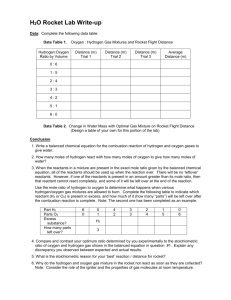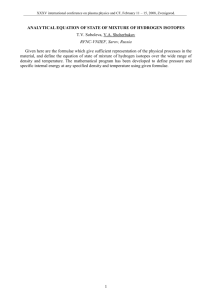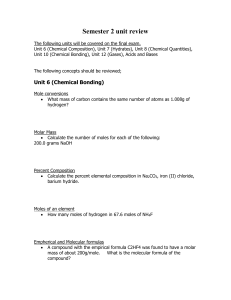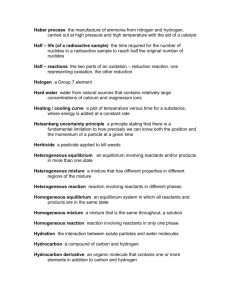Micro Mole Rockets Rachel Metzler Advanced Chemistry Lab #2
advertisement
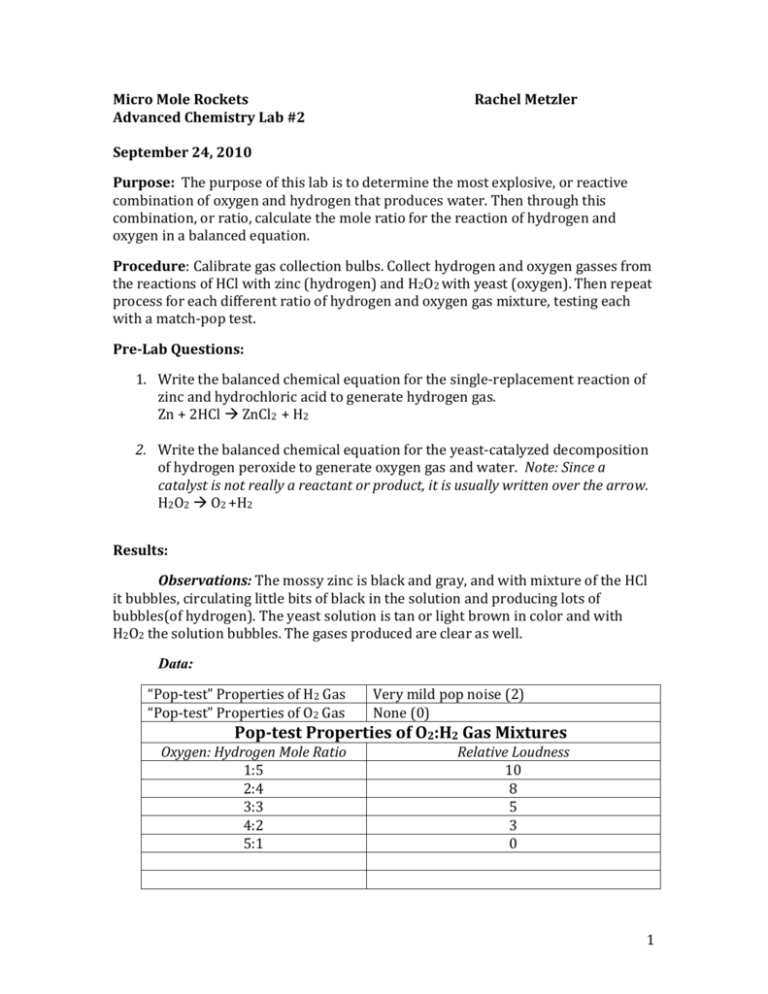
Micro Mole Rockets Advanced Chemistry Lab #2 Rachel Metzler September 24, 2010 Purpose: The purpose of this lab is to determine the most explosive, or reactive combination of oxygen and hydrogen that produces water. Then through this combination, or ratio, calculate the mole ratio for the reaction of hydrogen and oxygen in a balanced equation. Procedure: Calibrate gas collection bulbs. Collect hydrogen and oxygen gasses from the reactions of HCl with zinc (hydrogen) and H2O2 with yeast (oxygen). Then repeat process for each different ratio of hydrogen and oxygen gas mixture, testing each with a match-pop test. Pre-Lab Questions: 1. Write the balanced chemical equation for the single-replacement reaction of zinc and hydrochloric acid to generate hydrogen gas. Zn + 2HCl ZnCl2 + H2 2. Write the balanced chemical equation for the yeast-catalyzed decomposition of hydrogen peroxide to generate oxygen gas and water. Note: Since a catalyst is not really a reactant or product, it is usually written over the arrow. H2O2 O2 +H2 Results: Observations: The mossy zinc is black and gray, and with mixture of the HCl it bubbles, circulating little bits of black in the solution and producing lots of bubbles(of hydrogen). The yeast solution is tan or light brown in color and with H2O2 the solution bubbles. The gases produced are clear as well. Data: “Pop-test” Properties of H2 Gas “Pop-test” Properties of O2 Gas Very mild pop noise (2) None (0) Pop-test Properties of O2:H2 Gas Mixtures Oxygen: Hydrogen Mole Ratio 1:5 2:4 3:3 4:2 5:1 Relative Loudness 10 8 5 3 0 1 Calculations: None. Conclusion: Through this experiment it can be concluded that hydrogen and oxygen in a five to one ratio, respectively, creates the loudest popping noise. Discussion of Theory: Testing the ratios of hydrogen to oxygen allowed us to use the concept of mole ratios and limiting reactants in order to find the mole ratio of a hydrogen and oxygen reaction. Experimental Sources of Error: One source of error would be the tester bulbs. Their markings were not all exactly the same and after use the markings rubbed off slightly, leaving it harder to get exact measurements. This source of error could have affected the amounts of gas in each one, skewing the data. Post Lab Questions: (Answer any questions included in the lab. Answer in such a way that the meaning of the question is obvious in your answer. ) 1. Draw a bar graph to illustrate the relative loudness produced by pop-testing various oxygen/hydrogen gas mixtures. Relative Loudness 10 8 6 4 2 0 Relative Loudness 1:5 2:4 3:3 4:2 5:1 Oxygen:Hydrogen Ratio 2. The relative loudness of pure oxygen was a zero, and for hydrogen was a two in the pop test 3. The balanced chemical equation for the combustion reaction of hydrogen and oxygen to give water is: 2H2 + O2 2H2O 4. Complete the following sentence to describe the number of moles of each reactant involved in the combustion of hydrogen: ____4____ moles of hydrogen react with ___2___ moles of oxygen to give ____2____ moles of water. When the reactants in a mixture are present in the exact mole ratio given by the balanced chemical equation, all of the reactants should be used up when the reaction is over. There will be no “leftover” reactants. However, if one of the reactants is present in an amount greater than its mole ratio, then that reactant cannot react completely, and some of it will be left over at the end of the reaction. 2 5. Use the mole ratio of hydrogen to oxygen from Question #4 to determine what happens when various hydrogen/oxygen gas mixtures are allowed to burn. Complete the following table to indicate which reactant (H2 or O2) is present in excess, and how much of it will be left over after the combustion reaction is complete. Note: The second one has been completed as an example. Parts H2 Parts O2 Which reactant is present in excess? How much of that reactant is left over? 6 0 H2 5 1 H2 4 3 2 3 None O2 2 4 O2 1 5 O2 0 6 O2 6 3 n/a 3 4.5 6 1.5 6. Which oxygen/hydrogen gas mixture produced the most explosive mixture? Explain why this mixture was most explosive. The 1:5 ratio of oxygen to hydrogen gas mixture was the loudest. 7. Why do the hydrogen and oxygen gas mixtures in the collection bulb not react as soon as they are collected? Note: Consider the role of the match and the properties of gas molecules at room temperature. The gas mixtures do not react as soon as they are collected because it takes time for them to fully mix at room temperature. The match heats the gas molecules and so they react quickly. 3
